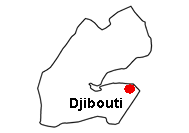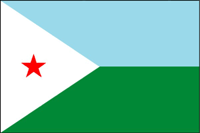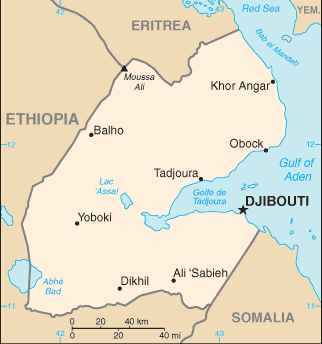|
|
 |
| |
back to top | ||
|
Population: While the cheetah is likely to live in Djibouti, it is in danger of extinction. The cheetah seems to live in the west Mille district of the Afar region (Werdanso region). Sightings report the cheetah in the Caluula, Skushuban and Qardho districts and in the Sidali region (data from 1963 to 2001). Principal Threats: The species is considered as a luxury good in the country and is very attractive to occasional poachers. The export of trophies from some regions is very important, but confiscation and punishment measures have been recently introduced. |
|||
|
|
|||
|
|||
|
Background: The French Territory of the Afars and the Issas became Djibouti in 1977. Hassan Gouled APTIDON installed an authoritarian one-party state and proceeded to serve as president until 1999. Unrest among the Afars minority during the 1990s led to a civil war that ended in 2001 following the conclusion of a peace accord between Afar rebels and the Issa-dominated government. In 1999, Djibouti's first multi-party presidential elections resulted in the election of Ismail Omar GUELLEH; he was re-elected to a second and final term in 2005. Djibouti occupies a strategic geographic location at the mouth of the Red Sea and serves as an important transshipment location for goods entering and leaving the east African highlands. The present leadership favors close ties to France, which maintains a significant military presence in the country, but is also developing stronger ties with the US. Djibouti hosts the only US military base in sub-Saharan Africa and is a front-line state in the global war on terrorism. |
|||
| |
back to top |
|
Area: total: 23,000 sq km; land: 22,980 sq km; water: 20 sq km Climate: desert; torrid, dry Terrain: coastal plain and plateau separated by central mountains Natural resources: geothermal areas, gold, clay, granite, limestone, marble, salt, diatomite, gypsum, pumice, petroleum Land use: arable land: 0.04%; permanent crops: 0%; other: 99.96% (2005) Irrigated land: 10 sq km (2003) Natural hazards: earthquakes; droughts; occasional cyclonic disturbances from the Indian Ocean bring heavy rains and flash floods Environment - current issues: inadequate supplies of potable water; limited arable land; desertification; endangered species Environment -
international agreements:
party to: Biodiversity,
Climate Change, Climate Change-Kyoto Protocol, Desertification, Endangered
Species, Hazardous Wastes, Law of the Sea, Ozone Layer Protection, Ship Pollution,
Wetlands |
|
| |
back to top |
|
Population: 486,530 (July 2006 est.) Age structure: 0-14 years: 43.3% (male 105,760/female 105,068); 15-64 years: 53.3% (male 135,119/female 124,367); 65 years and over: 3.3% (male 8,183/female 8,033) (2006 est.) Median age: total: 18.2 years; male: 18.7 years; female: 17.7 years (2006 est.) Population growth rate: 2.02% (2006 est.) Infant mortality rate: total: 102.44 deaths/1,000 live births; male: 110.07 deaths/1,000 live births; female: 94.58 deaths/1,000 live births (2006 est.) Life expectancy at birth: total population: 43.17 years; male: 41.86 years; female: 44.52 years (2006 est.) Total fertility rate: 5.31 children born/woman (2006 est.) HIV/AIDS - adult prevalence rate: 2.9% (2003 est.) HIV/AIDS - people living with HIV/AIDS: 9,100 (2003 est.) HIV/AIDS - deaths: 690 (2003 est.) Ethnic groups: Somali 60%, Afar 35%, French, Arab, Ethiopian, and Italian 5% Religions: Muslim 94%, Christian 6% Languages: French (official), Arabic (official), Somali, Afar Literacy: definition: age 15 and over can read and write; total population: 67.9%; male: 78%; female: 58.4% (2003 est.) |
|
| back to top | |
|
Data code: DJ Government type: republic Independence: 27 June 1977 (from France) Legal system: based on French civil law system, traditional practices, and Islamic law Political pressure groups and leaders: Union for Presidential Majority UMP (coalition includes RPP, FRUD, PPSD and PND); Union for Democratic Changeover or UAD (opposition coalition includes ARD, MRDD, UDJ, and PDD) [Ahmed Dini AHMED] |
|
| back to top | |
|
Economy - overview: The economy is based on service activities connected with the country's strategic location and status as a free trade zone in northeast Africa. Two-thirds of the inhabitants live in the capital city; the remainder are mostly nomadic herders. Scanty rainfall limits crop production to fruits and vegetables, and most food must be imported. Djibouti provides services as both a transit port for the region and an international transshipment and refueling center. Djibouti has few natural resources and little industry. The nation is, therefore, heavily dependent on foreign assistance to help support its balance of payments and to finance development projects. An unemployment rate of at least 50% continues to be a major problem. While inflation is not a concern, due to the fixed tie of the Djiboutian franc to the US dollar, the artificially high value of the Djiboutian franc adversely affects Djibouti's balance of payments. Per capita consumption dropped an estimated 35% over the last seven years because of recession, civil war, and a high population growth rate (including immigrants and refugees). Faced with a multitude of economic difficulties, the government has fallen in arrears on long-term external debt and has been struggling to meet the stipulations of foreign aid donors. GDP - real growth rate: 3.2% (2005 est.) GDP - composition by sector: agriculture: 17.9%; industry: 22.5%; services: 59.6% (2003 est.) Labor force: 282,000 (2000) Labor force - by occupation: agriculture: NA%; industry: NA%; services: NA% Unemployment rate: 50% (2004 est.) Population below poverty line: 50% (2001 est.) Agriculture - products: fruits, vegetables; goats, sheep, camels, animal hides Industries: construction, agricultural processing Industrial production growth rate: 3% (1996 est.) Exports: $250 million f.o.b. (2004 est.) Exports - commodities: reexports, hides and skins, coffee (in transit) Exports - partners: Somalia 66.3%, Ethiopia 21.5%, Yemen 3.4% (2005) Imports: $987 million f.o.b. (2004 est.) Imports - commodities: foods, beverages, transport equipment, chemicals, petroleum products Imports - partners: Saudi Arabia 21.9%, India 18.7%, China 10.1%, Ethiopia 4.8%, France 4.7%, US 4.3%, Japan 4.2% (2005) Currency (code): Djiboutian franc (DJF) Exchange rates: Djiboutian francs per US dollar - 177.72 (2005), 177.72 (2004), 177.72 (2003), 177.72 (2002) |
|
| |
back to top |
|
Telephone system: general
assessment: telephone facilities in the city of Djibouti are
adequate, as are the microwave radio relay connections to outlying areas of the
country Radio broadcast stations: AM 1, FM 2, shortwave 0 (2001) Television broadcast stations: 1 (2002) Internet country code: .dj Internet hosts: 1,540 (2006) Internet users: 9,000 (2005) |
|
| |
back to top |
|
Laurent A, Laurent D. 2002. Guépard. In Djibouti: les mammifères d'hier à aujourd'hui pour demain. p 175-177. |

